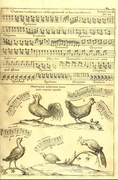The 2016 RISM Bird Count
Monday, February 15, 2016

The winter months keep most of us indoors, but this time of the year is greeted by birdwatchers on both sides of the Atlantic as they grab their binoculars and head outside for annual bird counts. There is the Christmas Bird Count in North America, the Big Garden Birdwatch in the UK, the Stunde der Wintervögel in Germany, and a garden bird count organized by the Ligue pour la Protection des Oiseaux in France.
As the results from these events come in, why don’t we conduct our own RISM bird count? You can leave your binoculars behind and go straight to the RISM online catalog!
The database does not offer a subject heading for birds in music, so full-text searches will have to guide you here. If we compare common birds with their sightings in RISM, we get the following:
-
Two sparrows from Korean collections, plus German sparrows (Sperlinge) together with a turtle dove, a pigeon, and a goldfinch
-
Five robin redbreasts but eight German Rotkehlchen
-
Thirteen blackbirds and sixteen German cousins (Amsel)
-
Over one hundred magpies (many thanks to Rossini)
-
One starling
The most abundant species this time of year seems to be the nightingale, if you total all sightings in English, German, and French - well over 800!
Nightingale: From Birds of Europe by John Gould, London, 1837. New York Public Library Digital Collections.
As we leave you to explore music featuring our feathered friends, we’ll pass on this eighteenth-century publication (RISM A/I: C 4544; the earliest edition dates from 1717), which according to Sarah Angliss was one of several methods used by people for the once-popular pastime of teaching melodies to birds:

The Bird Fancyer’s Delight, or Choice Observations And Directions Concerning the Teaching of all sorts of Singing Birds, after the Flagelet and Flute…within the Compass and faculty of each Bird, viz for the Canary-Bird, Linnet, Bull-Finch, Wood-Lark, Black-Bird, Throustill, Nightingale and Starling. Image from the University of Cardiff
A version is available digitized from IMSLP and Angliss has recorded some excerpts here.
Does anyone else have other sightings they’d like to report? Let us know in the comments below!
Search tip: Use Boolean operators to exclude sources where the bird is found in a person’s name. Do an Advanced Search and enter the bird in the field All fields, then enter the bird name in both the fields Other names and Composer. Select not from the drop-down menu that precedes these fields:

Image: Athanasius Kircher, Musurgia universalis, Rome 1650, lib. I, between p.30-31. Book held by the Music Library at University of North Carolina at Chapel Hill (US-CHH), via the Internet Archive. See also the brand-new revised translation (in German) currently in progress at the Hochschule für Musik und Theater Leipzig and the Deutsches Historisches Institut in Rome.
Share Tweet EmailCategory: In the news

